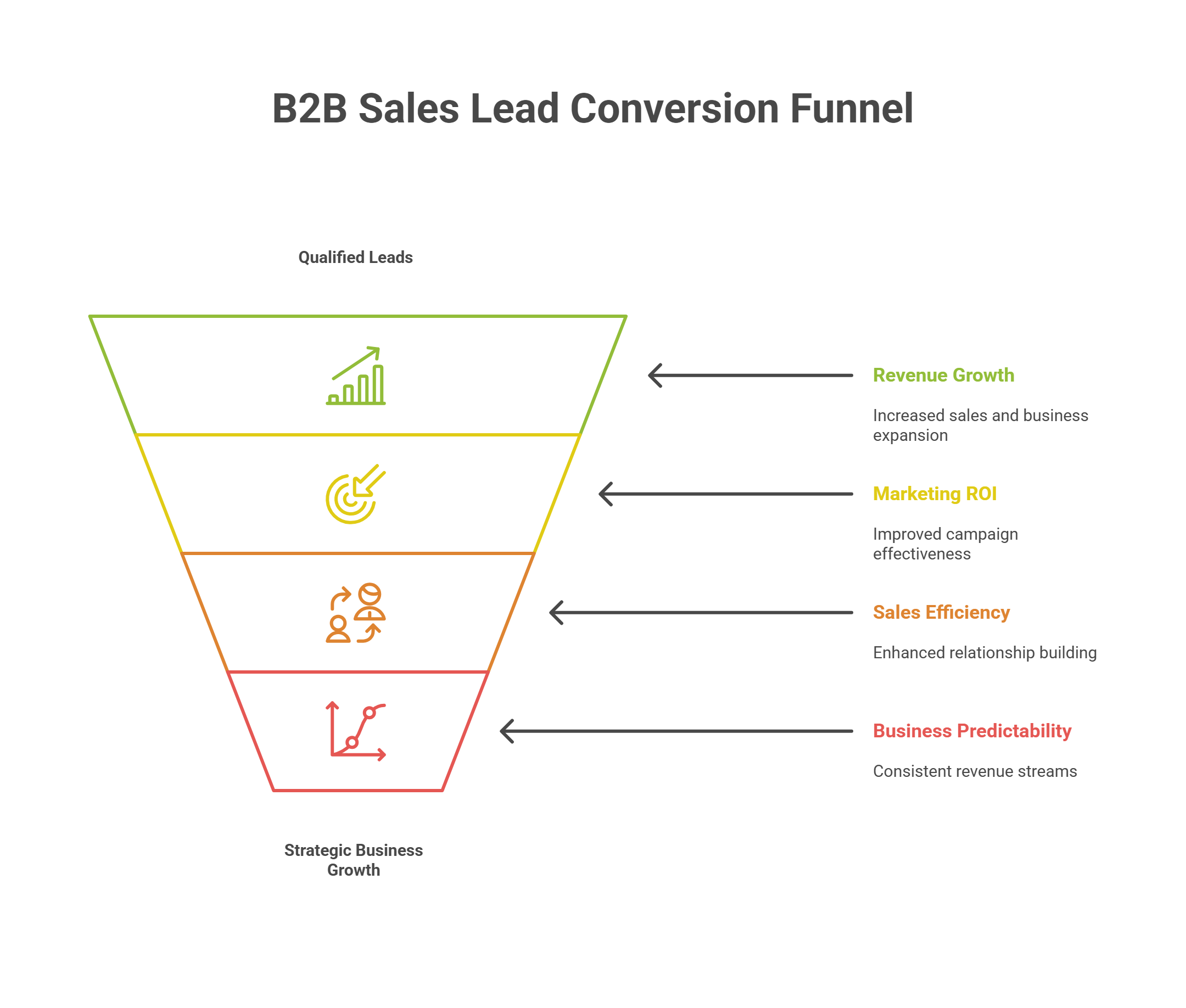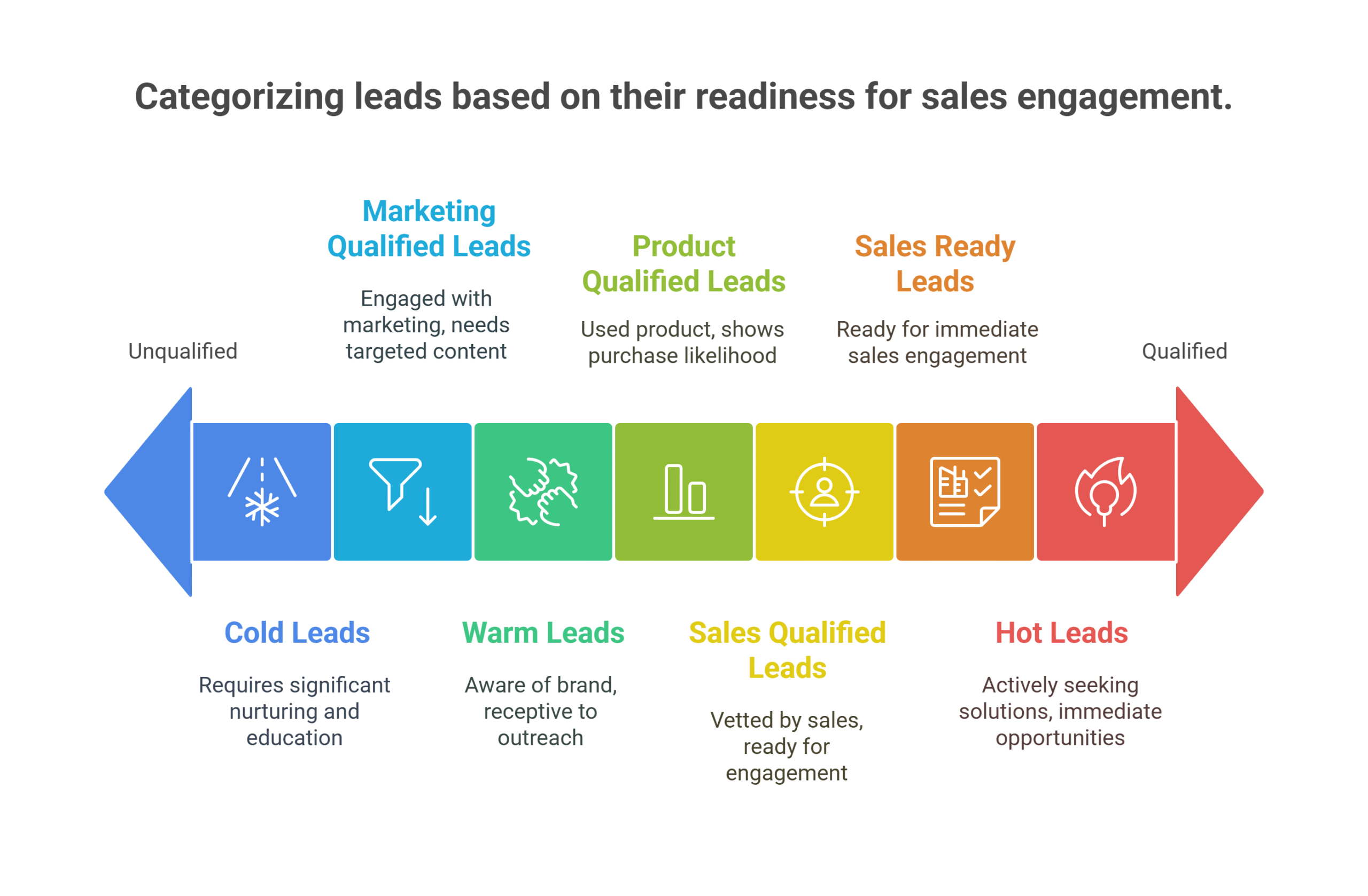In the competitive landscape of business-to-business commerce, understanding and mastering B2B sales leads represents the cornerstone of sustainable growth and profitability. As we navigate through 2025, the methods and strategies for generating, nurturing, and converting these leads continue to evolve, demanding a comprehensive understanding of both traditional approaches and emerging trends.
What Are B2B Sales Leads?
B2B sales leads are potential customers—whether individuals or companies—who have shown interest in your products or services and possess the characteristics that make them likely to purchase from your business. These prospects represent the lifeblood of any B2B organization, serving as the foundation upon which sales pipelines are built and revenue targets are achieved.
Unlike B2C leads, B2B prospects typically involve longer sales cycles, multiple decision-makers, and higher transaction values. They require careful nurturing and strategic engagement to move through the sales funnel successfully. The quality of these leads often matters more than quantity, as a single qualified B2B lead can result in substantial revenue over extended periods.
The Critical Importance of B2B Sales Leads

Without a steady stream of qualified leads, even the most innovative companies struggle to maintain growth momentum. B2B sales leads provide several strategic advantages that directly impact business success:
Revenue Growth Foundation: Every sale begins with a lead. The more qualified prospects in your pipeline, the greater your potential for revenue generation and business expansion.
Marketing ROI Optimization: Quality leads enable marketing teams to focus their efforts and budgets on prospects most likely to convert, significantly improving return on investment and campaign effectiveness.
Sales Efficiency Enhancement: When sales teams work with pre-qualified leads, they can dedicate more time to relationship building and closing deals rather than cold prospecting.
Business Predictability: A consistent flow of leads creates predictable revenue streams, enabling better forecasting and strategic planning for future growth initiatives.
Types of B2B Sales Leads

Understanding the different categories of B2B leads helps businesses tailor their approach and allocate resources more effectively:
Cold Leads
These prospects have had minimal or no interaction with your brand. They may fit your ideal customer profile but haven’t expressed explicit interest in your solutions. Cold leads require significant nurturing and education before they’re ready for sales engagement.
Warm Leads
Warm leads have shown some level of interest through actions like downloading content, attending webinars, or engaging with your social media. They’re aware of your brand and may be evaluating solutions, making them more receptive to targeted outreach.
Hot Leads
These high-intent prospects are actively seeking solutions and may have requested demos, pricing information, or direct contact. Hot leads represent immediate opportunities and should receive priority attention from sales teams.
Marketing Qualified Leads (MQLs)
MQLs have engaged with your marketing content and meet specific criteria indicating genuine interest, but they’re not yet ready for direct sales contact. They require additional nurturing through targeted content and engagement.
Sales Qualified Leads (SQLs)
SQLs have been vetted by the sales team and deemed ready for direct sales engagement. They’ve demonstrated clear buying intent and possess the authority, budget, and timeline to make purchasing decisions.
Product Qualified Leads (PQLs)
Common in SaaS and technology companies, PQLs have used your product through trials or freemium models and shown usage patterns indicating purchase likelihood.
Sales Ready Leads (SRLs)
These fully qualified prospects are ready for immediate sales engagement, having demonstrated clear intent, budget authority, and defined timelines for implementation.
Proven B2B Lead Generation Strategies
Content Marketing Excellence
Creating valuable, educational content serves as a powerful lead magnet. Develop comprehensive resources including:
- Industry Reports and Whitepapers: Position your company as a thought leader by publishing data-driven insights and industry analysis that address common challenges your prospects face.
- Case Studies: Showcase real-world success stories that demonstrate your solution’s value and ROI, helping prospects visualize potential outcomes.
- Webinars and Virtual Events: Host educational sessions that provide immediate value while capturing attendee information for follow-up nurturing.
- Blog Content: Maintain a consistent publishing schedule with SEO-optimized articles that answer common questions and provide solutions to industry problems.
Search Engine Optimization (SEO)
Optimize your online presence to capture prospects actively searching for solutions:
- Target long-tail keywords specific to your industry and solutions
- Create landing pages optimized for conversion
- Develop comprehensive resource centers that establish authority
- Implement technical SEO best practices to improve search visibility
Social Media Engagement
Leverage professional networks to connect with prospects:
- LinkedIn Marketing: Utilize LinkedIn’s advanced targeting capabilities for sponsored content and direct outreach to decision-makers.
- Industry Forums: Participate in relevant online communities where your prospects gather to discuss challenges and seek solutions.
- Social Selling: Train your sales team to use social platforms for relationship building and prospect identification.
Email Marketing Campaigns
Develop targeted email sequences that nurture prospects through the buying journey:
- Segment your audience based on industry, company size, and engagement level
- Create personalized content that addresses specific pain points
- Implement automated drip campaigns for consistent engagement
- A/B test subject lines, content, and send times for optimization
Partnership and Referral Programs
Leverage existing relationships for lead generation:
- Strategic Partnerships: Collaborate with complementary service providers to access their client base
- Customer Referrals: Implement formal referral programs that incentivize existing customers to recommend your services
- Channel Partners: Develop relationships with resellers and distributors who can generate leads in new markets
Networking and Events
Participate in industry events to build relationships and generate leads:
- Attend relevant trade shows and conferences
- Host your own networking events or user conferences
- Participate in industry associations and professional organizations
- Engage in speaking opportunities to establish thought leadership
Lead Conversion Best Practices
Lead Scoring and Qualification
Implement systematic approaches to evaluate and prioritize leads:
- Develop scoring models based on demographic and behavioral data
- Establish clear criteria for moving leads between stages
- Use marketing automation tools to track engagement and score leads automatically
- Regularly review and refine scoring criteria based on conversion data
Personalized Nurturing Campaigns
Create targeted content and messaging for different lead segments:
- Develop buyer personas to guide content creation
- Create content tracks for different industries and use cases
- Implement progressive profiling to gather additional prospect information
- Use dynamic content to personalize communications based on lead characteristics
Sales and Marketing Alignment
Ensure seamless handoffs between marketing and sales teams:
- Establish clear definitions for lead stages and qualification criteria
- Implement service level agreements (SLAs) for lead response times
- Create shared dashboards for visibility into lead status and progression
- Conduct regular meetings to discuss lead quality and conversion rates
Follow-up Strategies
Develop systematic approaches to stay engaged with prospects:
- Implement automated follow-up sequences for different lead types
- Use multiple communication channels including email, phone, and social media
- Provide value in every interaction through relevant content and insights
- Track engagement metrics to optimize follow-up timing and frequency
Measuring Success and Optimization
Key Performance Indicators (KPIs)
Track essential metrics to evaluate lead generation effectiveness:
- Lead Volume: Monitor the number of leads generated across different channels
- Lead Quality: Measure conversion rates from lead to opportunity to closed deal
- Cost Per Lead: Calculate the investment required to generate each lead
- Time to Conversion: Track how long leads take to progress through your sales funnel
- Return on Investment: Measure the revenue generated relative to lead generation costs
Continuous Improvement
Regularly analyze performance and optimize your approach:
- Conduct monthly reviews of lead generation metrics
- Test new channels and tactics to expand your reach
- Gather feedback from sales teams on lead quality
- Survey converted customers to understand their decision-making process
- Adjust strategies based on data-driven insights
Conclusion
B2B sales leads represent the foundation of business growth in today’s competitive marketplace. Success requires a comprehensive understanding of lead types, strategic generation approaches, and systematic conversion processes. By implementing the strategies outlined in this guide and maintaining a focus on continuous improvement, businesses can build robust lead generation systems that drive sustainable growth and profitability.
The key lies in combining traditional relationship-building approaches with modern digital marketing techniques, ensuring that every lead receives appropriate attention and nurturing based on their stage in the buying journey. As we move forward in 2025, companies that master these fundamentals while adapting to emerging trends will maintain competitive advantages in their respective markets.
Remember that effective B2B lead generation is not just about quantity—it’s about identifying and nurturing the right prospects who align with your ideal customer profile and can benefit most from your solutions. Focus on building genuine relationships, providing consistent value, and maintaining persistent yet respectful engagement throughout the entire sales process.
Frequently Asked Questions (FAQs)
What’s the difference between B2B and B2C leads?
B2B leads typically involve longer sales cycles, multiple decision-makers, and higher transaction values compared to B2C leads. B2B prospects often require more education and nurturing, as they’re making purchasing decisions that impact their entire organization. The buying process is more complex, involving research, approval processes, and budget considerations that can span several months.
How many touchpoints does it take to convert a B2B lead?
On average, it takes 6-8 touchpoints to convert a B2B lead into a customer. However, this can vary significantly based on your industry, product complexity, and deal size. High-value enterprise solutions may require 12-15+ touchpoints, while simpler SaaS products might convert with fewer interactions. The key is maintaining consistent, valuable engagement throughout the nurturing process.
What’s a good B2B lead conversion rate?
B2B lead conversion rates vary by industry and lead source, but generally range from 2-5% for cold leads and 10-20% for warm leads. Marketing qualified leads (MQLs) typically convert to sales qualified leads (SQLs) at rates of 13-27%, while SQLs convert to customers at approximately 20-30%. Focus on improving lead quality rather than just increasing quantity for better conversion rates.
How quickly should I follow up with B2B leads?
Speed is crucial in B2B lead follow-up. Research shows that leads contacted within the first hour are 7 times more likely to have meaningful conversations with decision-makers. Aim to respond to hot leads within 15-30 minutes, warm leads within 2-4 hours, and cold leads within 24 hours. Implement automated systems to ensure no lead falls through the cracks.
What’s the best channel for B2B lead generation?
There’s no single “best” channel, as effectiveness varies by industry and target audience. However, the most successful B2B companies typically use a multi-channel approach combining content marketing, LinkedIn outreach, email marketing, and SEO. Content marketing and referrals often generate the highest-quality leads, while social media and paid advertising can provide good volume for top-of-funnel awareness.
How do I qualify B2B leads effectively?
Use the BANT framework (Budget, Authority, Need, Timeline) as a starting point, but adapt it to your specific context. Key qualification questions include: Does the prospect have a genuine need for your solution? Do they have the budget allocated? Are you speaking with decision-makers or influencers? What’s their timeline for implementation? Use lead scoring to automate initial qualification based on demographic and behavioral data.
Should I buy B2B lead lists?
Purchased lead lists can provide volume but often lack quality and engagement. These leads haven’t expressed interest in your specific solution and may not be GDPR or privacy-regulation compliant. Instead, focus on organic lead generation through content marketing, SEO, and referrals. If you do purchase lists, ensure they’re from reputable vendors, properly segmented, and compliant with data protection regulations.
How long should I nurture B2B leads before giving up?
The nurturing timeline depends on your sales cycle length and industry. Generally, continue nurturing leads for 12-18 months if they remain engaged. However, prioritize recent, active leads over older, inactive ones. Implement re-engagement campaigns for dormant leads, and if they don’t respond after 2-3 attempts over 3-6 months, consider removing them from active campaigns while keeping them in your database for future reference.
What’s the role of marketing automation in B2B lead generation?
Marketing automation streamlines lead nurturing by delivering personalized content based on prospect behavior and characteristics. It enables lead scoring, automated follow-up sequences, and seamless handoffs between marketing and sales teams. Automation helps maintain consistent engagement at scale while freeing up time for sales teams to focus on high-value activities like relationship building and closing deals.
How do I measure B2B lead generation ROI?
Calculate ROI by dividing the revenue generated from leads by the total cost of lead generation activities, then multiply by 100 for a percentage. Track metrics like cost per lead, lead-to-customer conversion rate, average deal size, and customer lifetime value. Use attribution modeling to understand which channels and campaigns drive the most valuable leads, and adjust your strategy and budget allocation accordingly.




